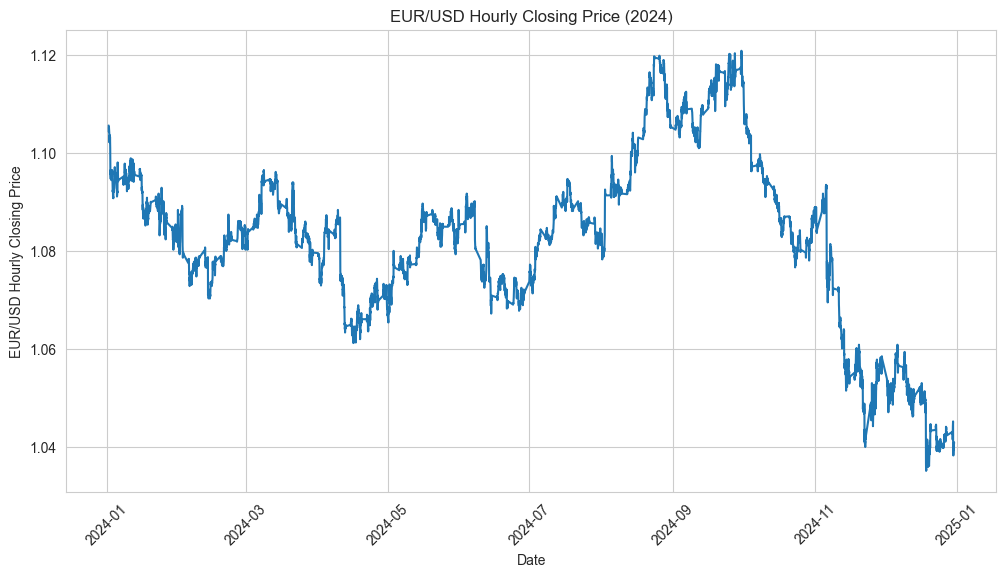Fetching and Visualizing Forex Data in Python with yfinance
I am preparing for a Forex-related interview, so after some research, I’ve summarized how to get Forex data in Python. In this blog, we will use yfinance and seaborn to fetch hourly exchange rates for EUR/USD, check the data quality, and finally, plot the closing prices in a line plot.
Install Packages
To get started, we need the following packages:
- yfinance: to fetch Forex data
- matplotlib: for plotting
- seaborn: for enhanced plotting with better visualization
1pip install yfinance matplotlib seabornFetch the Data
1import yfinance as yf
2import seaborn as sns
3import matplotlib.pyplot as plt
4
5sns.set_style("whitegrid")
6
7# Define the forex pair and date range
8pair = "EURUSD=X"
9# Define the start date and end date
10start_date = "2024-01-01"
11end_date = "2024-12-31"
12# Define the interval
13interval = '1h'
14
15# Fetch forex data
16forex_data = yf.Ticker(pair)
17
18
19# Fetch historical forex data
20data = forex_data.history(start=start_date, end=end_date, interval=interval)
21
22# Data overview
23data.info()
24
25"""Output
26<class 'pandas.core.frame.DataFrame'>
27DatetimeIndex: 6178 entries, 2024-01-01 18:00:00+00:00 to 2024-12-30 23:00:00+00:00
28Data columns (total 7 columns):
29 # Column Non-Null Count Dtype
30--- ------ -------------- -----
31 0 Open 6178 non-null float64
32 1 High 6178 non-null float64
33 2 Low 6178 non-null float64
34 3 Close 6178 non-null float64
35 4 Volume 6178 non-null int64
36 5 Dividends 6178 non-null float64
37 6 Stock Splits 6178 non-null float64
38dtypes: float64(6), int64(1)
39"""Data Quality Check
Missing values
We can check the missing values by
1data.isna().sum()
2
3""" Output
4Open 0
5High 0
6Low 0
7Close 0
8Volume 0
9Dividends 0
10Stock Splits 0
11dtype: int64
12"""No missing values, nice :)
Removing Irrelevant Columns
Upon closer inspection, we notice that the Volume, Dividends, and Stock Splits columns have all values equal to 0. These columns are not useful for our analysis, so let’s drop them.
1cols = ['Volume', 'Dividends','Stock Splits']
2(data[cols] == 0).all()
3
4""" Output
5Volume True
6Dividends True
7Stock Splits True
8dtype: bool
9"""
10
11data.drop(columns= cols, inplace = True)After this, we have a cleaned DataFrame.
1data.info()
2
3""" Output
4DatetimeIndex: 6178 entries, 2024-01-01 18:00:00+00:00 to 2024-12-30 23:00:00+00:00
5Data columns (total 7 columns):
6 # Column Non-Null Count Dtype
7--- ------ -------------- -----
8 0 Open 6178 non-null float64
9 1 High 6178 non-null float64
10 2 Low 6178 non-null float64
11 3 Close 6178 non-null float64
12 4 Volume 6178 non-null int64
13 5 Dividends 6178 non-null float64
14 6 Stock Splits 6178 non-null float64
15dtypes: float64(6), int64(1)
16"""Data Visulazation
We will now use seaborn to plot the hourly closing prices.
1import seaborn as sns
2import matplotlib.pyplot as plt
3
4# Set up the plot style
5sns.set_style("whitegrid")
6plt.figure(figsize=(12, 6))
7
8# Plot the hourly closing prices
9sns.lineplot(x=data.index, y=data["Close"])
10
11# Formatting the plot
12plt.xlabel("Date")
13plt.ylabel("EUR/USD Hourly Closing Price")
14plt.title("EUR/USD Hourly Closing Price (2024)")
15plt.xticks(rotation=45)
16plt.show()This will generate a line plot showing the hourly closing prices for the EUR/USD pair in 2024.

Conclusion
In this blog, we learned how to fetch Forex data using the yfinance library, cleaned the dataset by removing irrelevant columns, and visualized the EUR/USD hourly closing prices with seaborn. This simple step can serve as the foundation for more complex Forex analysis and hedging strategies.
#fintech #python #seaborn #yfinance